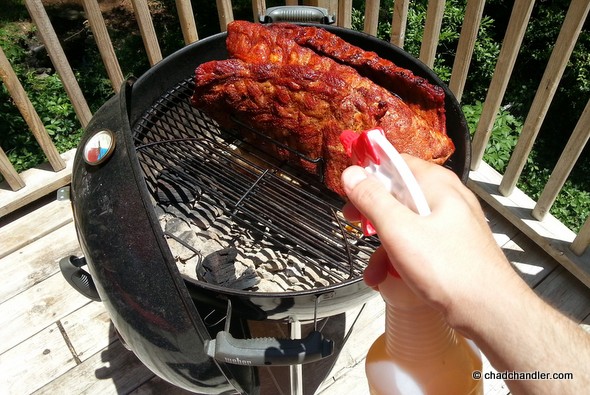
I grew up in the southeast where all BBQ is presumed to be pork, so beef BBQ is largely alien to me. I’ll go so far as to admit that I think smoked brisket is the most overrated BBQ in the USA. And don’t even get me started on that cloyingly sweet syrup that beef smokers are forced to slather on their “BBQ” to mask the obviousness of its inferiority and the disappointment in their unfulfilled lives. Why would anyone even spend good money on a sauce like Sweet Baby Ray’s when you can make it at home for pennies on the dollar? The recipe is one part water, two parts ketchup, and five parts cotton candy.
Seriously, though, I was born without a fully developed sweet tooth. Therefore I have a natural aversion to HFCS-based sauces. I don’t even understand people’s need to put any sauce on BBQ while it’s cooking. Like mayonnaise, BBQ sauce is a condiment. It should be up to each person to decide how much (if any) sauce is necessary to perfectly complement the meat. I play around with glazes while grilling otherwise-bland foods like chicken and pork loin, but I think BBQ (tough meat cooked low and slow with smoke) is already packed with plenty of flavor and should be prepared in a relatively simple fashion.
I’m a big user of rubs on BBQ, however. For beef, I’ve come to rely on a basic rub recipe. This recipe is largely scalable at 3:1 salt/pepper to everything else. You can add any number of additional ingredients to customize the flavor, but this is a good starting point.
Basic BBQ Beef Rub
- 1 tablespoon kosher salt
- 1 tablespoon coarse-ground black pepper
- 1 teaspoon garlic powder
- 1 teaspoon onion powder
- 1 teaspoon light brown sugar
- ½ teaspoon cayenne pepper
There are several ways to butcher beef ribs, but the most common cuts I see at the supermarket are spare ribs (where the meat is mostly on top of the bones–example) and back bone ribs (where the meat is mostly between the bones). Here’s my rack of back bone ribs.
I’m sorry for the poor picture quality. The wife was using the camera to make some new patterns for her sewing classes, so I had to take pictures with my smartphone.

Just like with pork ribs, you need to remove the membrane on the bone-side of the ribs or else the smoke won’t permeate the meat evenly. Some people say that if you remove it completely, the rack of ribs will fall apart on the smoker. That’s only true if you cook your ribs to “fall off the bone” tenderness, which means you’re overcooking them. So take the membrane off and cook your ribs properly. It’s thicker and more brittle than the membrane on pork ribs, so it might tear into a several pieces before it’s finally off.
Next, pat the meat down with a thin layer of rub and toss it on the cool side of your grill/smoker over a water pan. The pan catches the drippings and acts as a heat sink, helping to stabilize the temperature and keep the humidity up.

I’ve been cooking with mostly pecan wood chunks lately and I really like how mild the smoke tastes. Since the meat on beef ribs is usually thin and will only get thinner during the cook, I don’t want to overpower it with something strong like mesquite or hickory. I used equal parts pecan and apple wood in this cook because I was also smoking a couple of baby backs.
Smoke the ribs at around 250° (+/-25°), basting every so often to keep the meat moist. Baste it with whatever you want (water/beer/wine/vinegar/etc). I keep a spray bottle of 3:1 apple juice to cider vinegar in my basement fridge for southeastern-style pork BBQ, so I just use that.

The ribs are finished cooking when they reach an internal temperature of 180–200°, depending on how firm they feel. The firmer they feel, the longer they need to cook. Every rack has varying amounts of fat and cartilage that needs to render.

Finally, remove the ribs from the smoker and let them rest for 20 minutes or so. Then slice the ribs between the bones and serve with whatever sauce you like. The wife and I think these pair well with a mustard-based, SC-style BBQ sauce.

I prefer beef spare ribs to back ribs, but you get a lot more bang for your buck with back ribs.






